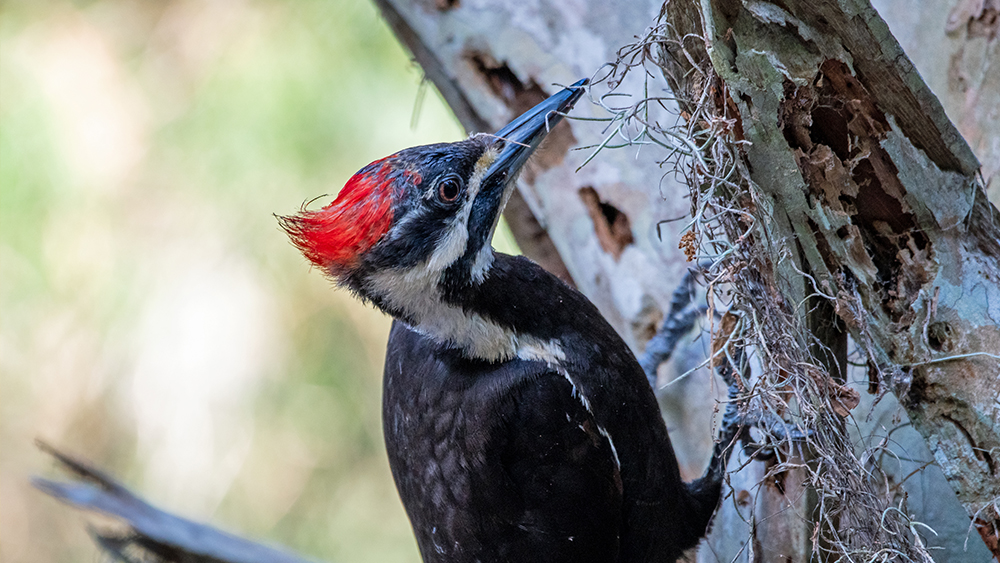The sweet melody of songbirds fills the air as the forest wakes up. But there is another familiar voice that joins in the morning songs: woodpecker. The woodpecker doesn’t join in with a voice, but with percussion, drumming a rhythm on trees like a wooden instrument.
According to an article posted on ScienceDaily.com, song birds use complex muscle coordination to produce their songs; they learn their song as young birds. The muscle coordination is controlled by a specialized region of the brain, expressed with a marker gene called parvalbumin (PV). Scientists tested for the PV gene in non-songbirds. The only non-song bird they tested to have the PV gene was a woodpecker.1 Woodpeckers don’t just use their beak to drill into trees, they use it to drum rhythmic communications instead of singing. A study published in the journal PLOS Biology said:
“[Woodpeckers] contained several pallial nuclei with specialized PV up-regulation, which were in regions where song nuclei of vocal learners are located. However, instead of showing activations during vocalization, these regions showed activation during drumming.”2
For a woodpecker, drumming is their song.
According to a Nature documentary, woodpeckers are found in every forest type almost everywhere in the world, 239 species in all. Each species with its own unique drumming pattern.3 According to the study published in PLOS Biology, “Studies in multiple woodpecker species also suggest that drums may encode individual identity and that woodpeckers can distinguish drums produced by their neighbors compared to those that they have never encountered before.”2 Woodpeckers drum to announce themselves, claim territory, and impress mates.3
Woodpeckers have large zygodactyl feet, meaning they have two toes that extend forward and one to two toes that extend backwards.4 They use their feet like grappling hooks to cling to tree trunks. Woodpeckers also have stiff tail feathers specially designed to use as support against the tree. These features combined creates a tripod, stabilizing the bird and giving them the proper leverage needed to drum and drill into trees.3
Evolutionist scientists believe because songbirds and woodpeckers share the same PV gene, they must have evolved at about the same time, they just took different paths, one of song and one of percussion.2
There are many problems with the theory of evolution, especially where the woodpecker is concerned. Woodpeckers do not merely tap on trees instead of singing. They drill into trees to find food and create homes. Woodpeckers are fitted with specialized features, equipping them for their special role within their eco-system. If an animal not designed to drill into trees attempted to do what a woodpecker does, they would likely die from their injuries.
In The Evolution of a Creationist, Dr. Jobe Martin described a theoretical Darwinian scenario by which the woodpecker might have tried to evolve. He described a bird trying to find insects inside a tree by pecking into the tree. This bird ran into issues immediately. “Its beak shattered when it slammed against the tree, its tail feathers broke, and it developed a migraine-strength headache. With a shattered beak, the little bird was unable to eat and so it died.”5 A dead animal cannot further evolve.
Dr. Brian Thomas wrote in a 2011 ICR article, “The woodpecker has long been considered a living refutation of big-picture evolution…There is no natural way for a whole suite of required, specified features to just ‘get together’ all at one time.”6
How woodpeckers acquired their features might stump evolutionists, but creation scientists point to Jesus Christ, Engineer of all creation. On the fifth day of the Creation Week. “God created…every winged fowl after his kind: and God saw that it was good,”7 including woodpeckers, whom He specially designed to drum and drill into trees.
References
- Drumming in Woodpeckers Is Neurologically Similar to Singing in Songbirds, Study Finds. Posted on ScienceDaily.com September 20, 2022, Accessed June 28, 2023.
- NATURE: Woodpeckers - The Hole Story. PBS, 2022.
- Schuppe, Eric R. Et al. Forebrain Nuclei Linked to Woodpecker Territorial Drum Displays Mirror Those that Enable Vocal Learning in Songbirds. Posted on PLOS Biology September 20, 2022, Accessed June 28, 2023.
- Merriam-Webster.com Dictionary, s.v. “zygodactyl,” accessed June 28, 2023.
- Martin, J. 2002. The Evolution of a Creationist. Rockwall, TX: Biblical Discipleship Publishers, 265.
- Thomas, B. Woodpecker Inspires Designers, Knocks Evolution. Posted on ICR.org February 23, 2011, Accessed June 28, 2023.
- Genesis 1:21.
















